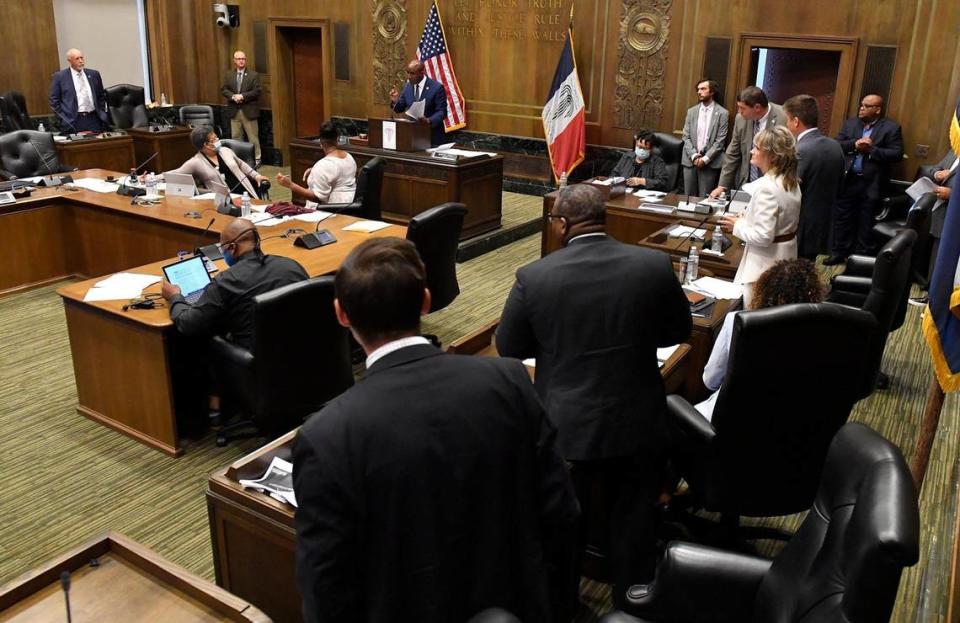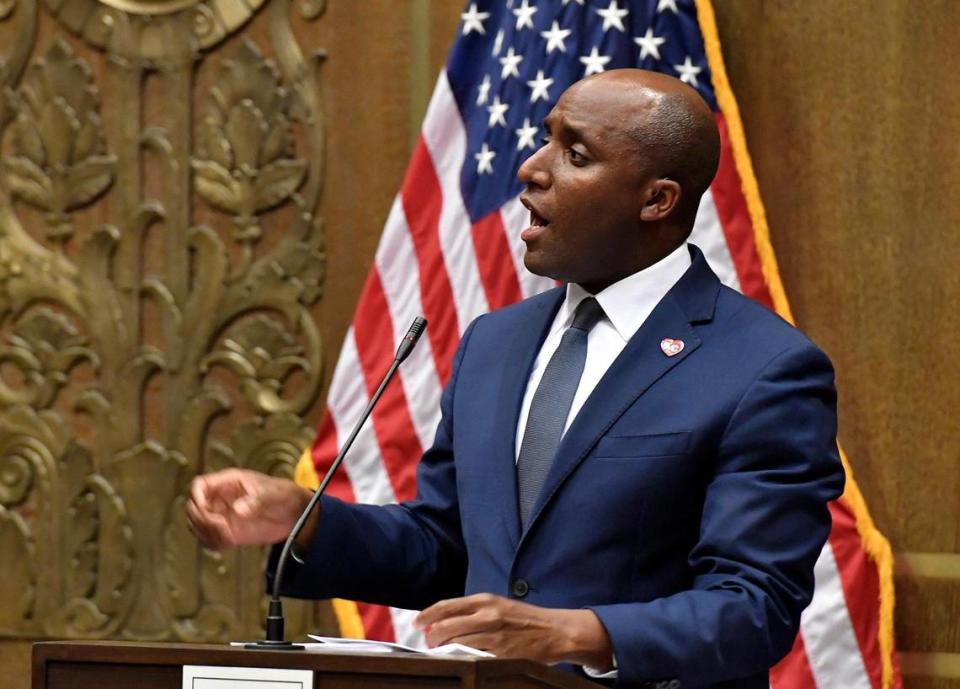Kansas City relaxes rules for housing developers. Here’s what that could mean for rent
In a heated Thursday meeting, the Kansas City Council voted to relax affordable housing requirements for developers seeking tax incentives from the city, walking back on a set of rules that the council approved unanimously about a year and a half ago.
Passed in a 9-4 vote, the ordinance allows tax incentives to go to developers without the requirement of setting aside “extremely affordable” units for tenants with low incomes. Developers will still have to set aside some units as affordable, but the rent rate for these units is higher: about $1,200 a month for a one-bedroom apartment.
The ordinance received intense pushback from housing groups, namely the citywide tenant union KC Tenants, but also Kansas City Public Schools because of the way tax breaks for developers affect how much potential property tax revenue will go to city schools.
Kansas City tenants make an average monthly income of $2,500 and pay more than half of that to housing costs, according to early findings from a KC Tenants online survey with 700 respondents. Paying the city-deemed affordable rent of $1,200 for the average survey respondent would still take up nearly half of their income, which the federal government considers a “severe cost-burden.”
This new ordinance was just a piece of a package of housing policies Kansas City Mayor Quinton Lucas proposed recently. Here’s what it actually means for renters, and how other recent city council decisions could affect rent, too.
What exactly did the city council pass?
The city council passed one piece of a new housing plan, also known as ordinance 220700.
In exchange for tax incentives from the city, the new ordinance requires housing developers to set aside one-fifth—or 20%—of the housing units in a new development as “affordable” for people who are earning 60% of the median family income. The remaining majority of housing units in proposed developments can be market rate.
The council also voted to add a $175 million bond issue for Kansas City voters to decide on in November. If approved, $50 million of that money would go toward the city’s affordable Housing Trust Fund—more on that in a second.

How does the city decide what rent is affordable?
The city calculates what’s considered “affordable” based on the federally-set median family income for the Kansas City metro area. This median income number factors in the incomes of homeowners and renters in both rich and poor areas in the metro, including areas like Johnson County.
For a single person, the area median income is about $68,000. For a family of four, It’s about $98,000.
The city uses this federally-set number to come up with what the income limits and rent caps will be for specially set aside “affordable” apartments in new developments.
Affordable housing advocates criticize this method because they argue that including higher income homeowners and jurisdictions skews the median income higher than what many city tenants actually make. They argue that with this kind of calculation, even rents that are deemed “affordable” by the city are still unaffordable to many Kansas City tenants.
What’s so different about the new affordability rules from the old ones?
The main change is that the city raised the income threshold it will use to calculate what rent is affordable for the specially set aside units in new developments.
Under the newly passed rules, the city will base the rent caps and income limits for affordable apartments on 60% of the median income.
The past requirements included apartments for those making up to 30% of the median income, as well as those making up to 70% of the median income.
That change from the previous rules setting aside apartments for those making 30% of the median income, to the new rules setting aside apartments for those making 60% of the median income, almost doubles the cost of rent that the city now considers affordable.
The mayor’s reasoning for changing these rules is that no developers applied for tax incentives in the first year and a half these affordability rules were in place.
District 3 Councilwoman Melissa Robinson voted in favor of the relaxed requirements, but she acknowledged that the new rules won’t benefit Kansas Citians with lower incomes.
“This is not affordability for everyone,” she said on Thursday. “But it’s affordability for some people, especially middle-class people.”

What do these new rules actually mean for rent?
When developers get money from the city to build new housing, they will need to keep the rent for a certain number of apartments affordable to those making up to 60% of the median income. Then after that, the majority of the units in these new tax-backed developments will be market rate.
According to the city’s calculations, 60% of the median income for a two-person household in the Kansas City metro is about $47,000. One of these set aside affordable one bedroom apartments for that household would have a rent around $1,200.
The benchmark for affordable rent changes depending on the size and income of the household.
A family of four earning around $59,000 per year, for instance, could qualify for a three bedroom apartment with rent around $1,500.
What’s the reason behind the change?
Since those previous regulations were put in place in 2021, the city didn’t get any applications from developers looking to receive tax incentives and build affordable housing. The mayor suggested that relaxing the requirements would encourage developers to break ground throughout the city.
The city’s Economic Development Corporation did receive 31 applications for housing projects looking for tax breaks right before the council passed the 2021 ordinance for affordability regulations. That was the most applications received for projects seeking tax breaks in over three years.
“Unfortunately, since that time we’ve not seen the production of units,” Lucas said during the Neighborhood Planning and Development Committee on Wednesday.
Did the council pass anything else that will affect housing?
Yes, council also voted to put a $175 million bond issue on Kansas City voters’ November ballot.
This money would be coming from a general obligation bond, which is almost like a loan for local governments.
If voters approve the bond, it would put money toward a number of projects in the city.
Those projects include $45 million in repairs to Bartle Hall, $80 million in community center renovations (think swimming pools, playgrounds and other amenities) and $50 million toward the city’s Housing Trust Fund.
City residents voted on a similar GO bond in 2017, which went toward repairing the city’s infrastructure. The $800 million bond will be paid back by way of city taxes, including property taxes.
What is the Housing Trust Fund, and how will the extra money be used?
The Housing Trust Fund is a pot of government money that the city has reserved for helping fund affordable housing projects throughout the city.
Last month, 14 affordable housing projects were approved for $8 million in funding.
The Housing Trust Fund currently does not have close to the amount of money in it that it was designed to have. The fund is made up of $12.5 million of federal COVID relief funds from the American Rescue Plan, and an additional $10.5 million in local money that will be distributed over the next 25 years.
If voters approve the upcoming $175 million bond issue in November, the Housing Trust Fund will receive $50 million, which will put it closer to its intended $75 million budget.
Projects applying to receive money from the trust fund are screened and reviewed by a board of local housing advocates and experts. Those proposals are then sent to the city council for approval.
So what’s next?
The mayor’s original housing plan also included a measure that would fundamentally change the way new development projects getting tax breaks are approved in City Hall by giving the city manager power to approve standardized incentives for projects, rather than the City Council and economic development boards that now have oversight.
The mayor has said this change would help “fast track” projects, adding that developers have said it’s too difficult to build in Kansas City. Affordable housing advocates have argued that this ordinance would reduce opportunities for debate through public meetings.
This piece of the plan was put on hold during Wednesday’s Neighborhood Planning and Development committee meeting, as well as an ordinance that would regulate accessory dwelling units.
The Star’s Kevin Hardy and Anna Spoerre contributed reporting.
This story was republished to change the headline from “Here’s how that could raise rents” to “Here’s what that could mean for rent” because the ordinance only directly changes the rules and raises the rent caps for future developments. It does not directly change current rents in Kansas City development projects.
Do you have other questions about housing in Kansas City? Ask us at kcq@kcstar.com.

